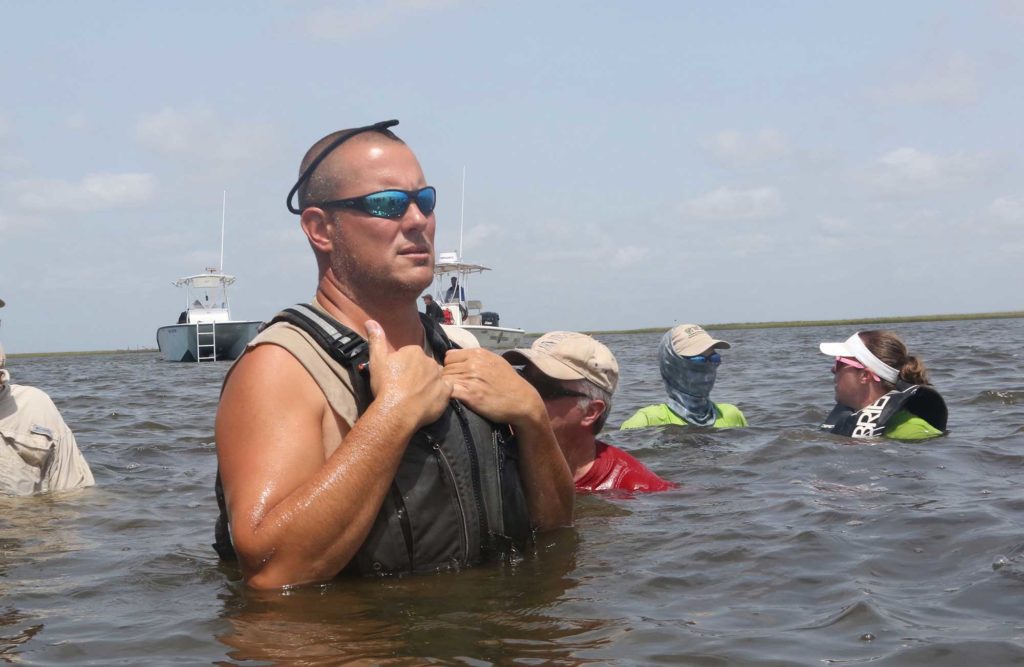On August 29, Category 4 Hurricane Ida smashed into southern Louisiana packing 150mph winds and a central pressure of 930mb. As the storm tracked north and east, wreaking havoc as it progressed, a surge of water that was estimated as high as 6 feet sloshed across Lake Pontchartrain and inundated low-lying areas around Slidell (LA). Unbeknownst at the time, Ida brought more than just floodwaters to the northeast shore of the lake.
From my house in Charleston (SC), I watched coverage of the storm's path with a mix of horror and fascination.
NMMF’s Conservation Medicine team in South Carolina has become familiar with stretches of the ‘land of the bayous’ over the past decade, first from our work assessing dolphin health in Barataria Bay in the years following the Deepwater Horizon disaster, second, and more recently, in response to dolphins displaced in previous storms that have impacted swathes of southern Louisiana.
Nearshore bottlenose dolphins can become displaced or ‘out-of-habitat’ (OoH) when they are pushed inland by storm surge and then left stranded, as the waters recede, in land-locked canals, drainage ditches, ponds and lakes, and ephemeral pools. Far and away, the primary concern after a hurricane is the safety and well-being of the human populace. But almost invariably, as officials and locals make their way into storm-ravaged areas to aid survivors and assess damage, they come across OoH dolphins.
Typically, reports of OoH dolphins don’t come in until days or weeks after a hurricanes passage, but in the case of Hurricane Ida, it didn’t take that long. Barely 24 hours after Ida’s landfall near Port Fourchon, Audubon Nature Institute’s Coastal Wildlife Network received a report of a dolphin in a canal in the Eden Isle subdivision, south of Slidell. In turn, the report was relayed to NOAA Fisheries’ Southeast Marine Mammal Stranding Network. Complicating the situation, many of the Audubon staffers had evacuated the New Orleans-area in anticipation of Ida. The plight of this dolphin also quickly garnered coverage on social media and local news outlets.
As far as where the dolphin was trapped, the water was presumed to be largely fresh and the level of the water was receding, neither fact of which were good for the dolphin.
NMMF and other entities stepped up to help the Audubon folks, who were still in ‘recovery’ mode in assessing the developing situation. NMMF Conservation Medicine Operations Manager Brenda Bauer lives in the region and was able to travel to the site of the OoH dolphin and relay important information on the dolphin’s appearance and local conditions. A NOAA Law Enforcement officer, who was also a local resident, provided details on the canal system itself, including operation of the pump system east of the dolphin’s location, as well as the likely means of the dolphin getting in the canal.
Based on these observations, the dolphin was judged to be a sub-adult, in OK body condition, albeit with indication of on-going freshwater exposure (focal lesions and patches of algae on its skin) and superficial lacerations (possibly a result of being washed into the canal). Respiration (rate and quality) were judged normal. As far as where the dolphin was trapped, the water was presumed to be largely fresh and the level of the water was receding, neither fact of which were good for the dolphin. With this information in hand, NOAA Fisheries began the process of planning the dolphin’s rescue. By September 1, less than 3 days post-Ida, a plan was in place.
Catch day dawned to beautiful weather.
Initially we aimed to conduct the rescue on the following Tuesday (September 7) but on the 2nd came reports that the dolphin’s respiration rate was elevated. These observations prompted NOAA to move the rescue up to Sunday (September 5). Changing the rescue date caused changes in the field team and in available resources, but there was good news too. Audubon staff were able to gain access to their stranding supplies, namely their climate-controlled ‘ambulance’.
In the lead up to the rescue, an important consideration was the need to be sensitive to the situation of the local inhabitants. Many residents were still without power and/or had limited access to water, and there were long lines at area gas stations. It was important to balance our efforts to rescue the dolphin with the daily plight of the residents of Slidell and surrounding communities. Fortunately, each day brought news that power was gradually being restored. With electricity returning, public awareness of the dolphin grew, and folks were getting more and more strident about helping the dolphin.
Labor Day weekend brought a flurry of last-minute activity. A SeaWorld Rescue contingent (coming from Texas and Florida) arrived in Mobile. I drove from Charleston to meet up with them. Organizations (Audubon Nature Institute, Institute for Marine Mammal Studies, Dauphin Island Sea Lab, and NOAA) in the northern Gulf gathered and staged gear, readying it for use the following day, Sunday, September 5.
Catch day dawned to beautiful weather – not a cloud in the sky, little to no wind, temps in the high 80’s. As we pulled up to the site, I was taken aback by size of the crowd already on hand. I don’t think I’ve ever been a part of such a public rescue. It didn’t seem like the locals were going to begrudge us rescuing the dolphin. In fact, to a person, they were overwhelmingly supportive (and ultimately appreciative) of our efforts. Sizable law enforcement presence was on hand too, for crowd control purposes.
The rescue team gathered for a pre-capture briefing: introductions, outline the plan to catch the dolphin, assign roles, and sketch out what would come once we had it in hand, and once more emphasize safety. All the while, the dolphin went about its usual routine, surfacing 1-2 times per minute, oblivious to what we had in store for it.
After the briefing, team members scattered to their various tasks. A net was stretched across the western-end of the canal to prevent the dolphin going that way. At the other end, nearer to the pumping station, a couple kayaks were launched to herd the dolphin away from this structure, more toward the middle of the small canal. As expected, the dolphin obligingly moved away from the kayaks. Once it was far enough from the pumps, a second net was stretched across that end of the canal to prevent the dolphin going back in that direction. Now we had the dolphin where we wanted him – pretty much in the center of the canal.
A third, longer net was pulled across the canal, and it’s far-end was held along the shore to the second ‘blocking’ net. The far-end was then pulled back to the south side of the canal thereby making a ‘U’ shaped enclosure, with the dolphin, seemingly unfazed, swimming inside. Handlers were positioned at intervals around the outside of the net as both ends were slowly pulled onto the bank, shrinking the available area inside the net enclosure. We half-expected the dolphin to strike and become entangled in the net by now, but these estuarine dolphins are savvy to complicated, enclosed spaces. Our guy showed no inclination to tangle with the net.
Since the dolphin didn’t seem inclined to hit the net, a few handlers stepped over the float line into the net enclosure. The dolphin seemed unconcerned by our presence as it swam between us and the reedy bank. A handler briefly ran his hand down the dolphin’s back, prompting little to no visible reaction. I reached out placing my hand on its dorsal fin, again little to no reaction. The dolphin pivoted and began slowly swimming back in the direction it had come. With little space between us and the bank, we stepped in and were able to get our arms around the dolphin, who didn’t struggle. I was quickly struck by the small (barely six feet long) size of the dolphin.
Once we had the dolphin in hand, the vet team quickly moved in to preliminarily assess ‘his’ (turned out the dolphin was a male) condition, while preparations were made to get him out of the water and into the Audubon ‘ambulance’. The dolphin’s small size prompted a hurried conference call amongst NOAA staffers, to determine whether to proceed with the plan to release the dolphin to the Gulf or take him to a facility for rehab/treatment. This didn’t impact us in the short term though, as both the release location and the nearest rehab facility in Gulfport (MS), were to the east, so same route to start.
Soon thereafter, the dolphin was carried up the embankment into the back of the ambulance and placed in a stretcher supported inside a wet transport (a fabric-sided tank half-filled with water). This way, the dolphin was secure for the transport while being supported (and cooled) by the water. Vets and handlers piled into the back of the ambulance and the caravan set off, for parts unknown (for the time being). Slidell police, St. Tammany Parish Sheriffs, and NOAA Law Enforcement provided a full-on police escort through the streets of Slidell, sirens wailing and lights flashing! It was quite the show!
Once through Slidell, we took a ramp onto Interstate 10, heading for the Mississippi line, still with our police escort. NMMF’s Brenda Bauer took the lead (she had reconnoitered the route beforehand), followed by police cruisers, the dolphin ambulance, trucks carrying the rescue team, and more police cars bringing up the rear. Upon reaching the state line, Hancock County (MS) police were standing by to take up escort duties. This was really some event! At about this time, we got word that the decision had been made to proceed with the release. Although the dolphin was on the small side, he seemed in good shape, and previous work in the northern Gulf suggested that dolphins in this area tended to be smaller than average.
The caravan made its way south off of Interstate 10 toward the coast. By all accounts, the dolphin (Poncho by name) tolerated the transport well. The attending vets collected blood to gain a more in-depth picture of his health, and the handlers kept him cool and comfortable (or as comfortable as could be cruising along at 45 mph down state highways). We soon arrived at the release site, to the east of Lakeshore (MS). Providentially, there was a small covered concrete pad right where we planned to disembark the dolphin. We set up a mat there in the shade, carried the dolphin from the ambulance, and placed him on the mat.
We quickly took photos to document the condition of the dolphin (basically take pics of his entire body, top, bottom, and sides). Even in this short amount of time, another crowd had gathered around us, very interested in the out of the ordinary goings-on. But just like back in Slidell, even though they were awful curious about these out of the ordinary goings-on, the public was well-mannered and respectful of the rescue team and the procedures.
Before you knew it, Poncho was ready to go back to the Gulf.
A team of handlers hoisted the stretcher with him inside and marched down to the shoreline and out into the water. We carried him out to where the water was about 4 feet deep, took him out of the stretcher, oriented him facing east, and cut him loose. Upon release, he was quite polite, no big kicks with his flukes, or turning sideways, nothing like that, just a strong couple strokes and gone. He was observed to resurface one time, about 20-30 seconds post-release, pretty high surface with some white water heading north.
All-in-all it was a successful rescue (knowing right where the dolphin is located saves a lot of time and headache!). It’s been a busy year for rescues in coastal Louisiana (Poncho was the 8th OoH dolphin since September 2020 that we have helped out with), so it was good to catch up with many of our fellow responders. Fortunately, the area around Slidell was largely unscathed by Ida, certainly in comparison to communities south of New Orleans. Places like Grand Isle and Golden Meadow appear to have gotten it just as bad, if not worse, than areas around Cameron Parish, in western Louisiana last year. As more people begin to re-populate these hard hit areas, I’m willing to bet there will be more OoH dolphins found. And the call to mount a response will go out again. And we standby ready to respond.
Photos by Institute for Marine Mammal Studies
Please consider donating today to help our team get to the animals when we are most needed. We cannot do this without your support!
About the Author
Eric Zolman, Conservation Medicine Biologist, received his master’s degree in marine biology from the University of Charleston in 1996, documenting a year-round resident stock of bottlenose dolphins in the Stono River estuary near Charleston, SC as part of his thesis research. He has since continued his research on bottlenose dolphins in the Charleston area and along the southeast U.S. coast. His research interests include dolphin habitat use, behavior, and movements with a focus on conservation of estuarine and nearshore stocks.



